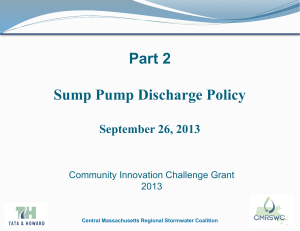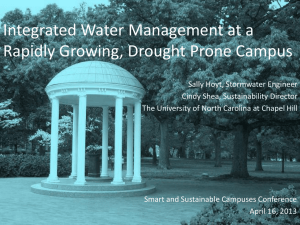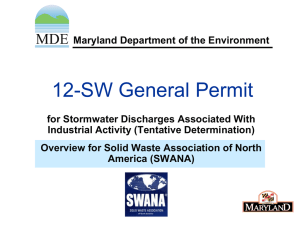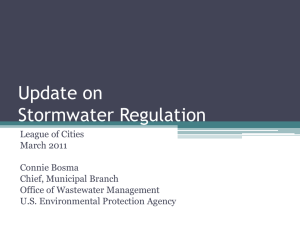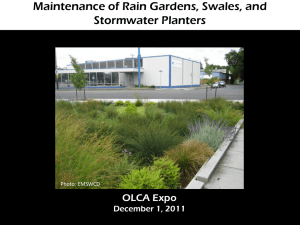SWPPP Template - Central MA Regional Stormwater Coalition
advertisement
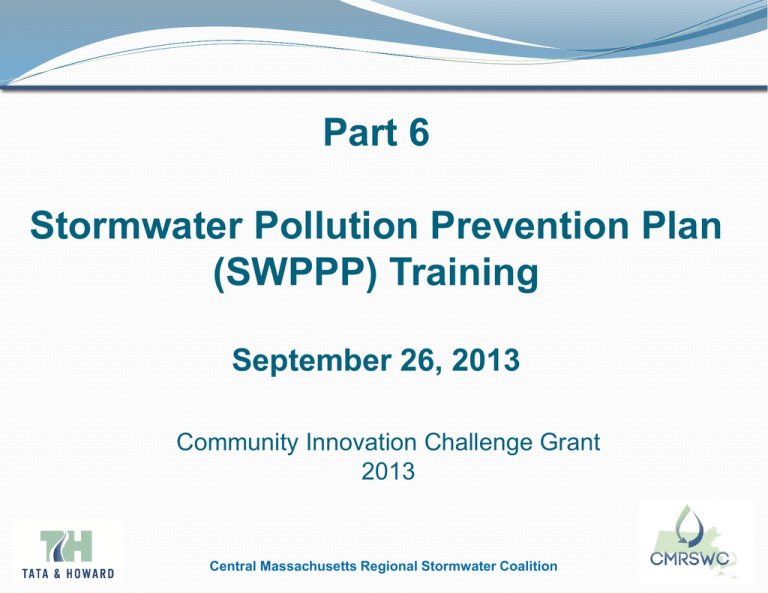
Part 6 Stormwater Pollution Prevention Plan (SWPPP) Training September 26, 2013 Community Innovation Challenge Grant 2013 Central Massachusetts Regional Stormwater Coalition Components of the CMRSWC SWPPP Section 1: Overview Section 2: Evaluation Section 3: Municipal Facilities Assessment • Facilities with low pollution potential • Facilities with detailed narratives Section 4: Detailed Facility Narrative • Site or facility summary • Pollution Prevention Team • Site activities • Material and equipment inventories • Structural BMPs Section 5: Non-Structural Controls (= SOPs!) Central Massachusetts Regional Stormwater Coalition Current Requirements Currently (2003 MS4 Permit) Section MCM #6 Scope “preventing and/or reducing pollutant runoff from municipal operations”; “schedules for municipal maintenance”; “inspection procedures and schedules for long-term structural controls” Types of Facilities “at a minimum, maintenance activities for the following: parks and open space (areas such as public golf course and playing fields); fleet maintenance, building maintenance, new construction and land disturbance; and roadway drainage system maintenance and stormwater system maintenance” Pending Requirements: Scope Likely in 2013/2014 New MS4 Permit Section Scope 2.3.7.1 (O&M Programs) “Implement an operations and maintenance program for permittee operations that includes a training component and has a goal of preventing or reducing pollutant runoff and protecting water quality from permittee operations” Part of the Stormwater Documentation Management Plan (SWMP) 2.3.7.2 (SWPPP) “develop and fully implement a SWPPP” SWPPP shall contain: i. Pollution Prevention Team ii. Description of facility and ID of pollutant sources iii. ID stormwater controls iv. Include practices to minimize/prevent exposure; good housekeeping; preventative maintenance; spill prevention and response; erosion & sediment control; manage runoff; salt storage; training; maintain control measures v. Inspections vi. Repair or update BMPs Separate from the SWMP Pending Requirements: Facilities Likely in 2013/2014 New MS4 Permit Section Types of Facilities Schedule 2.3.7.1 (O&M Programs) a. Parks and open space b. Buildings and facilities where pollutants are exposed to stormwater runoff c. Vehicles and equipment d. Infrastructure: catch basins; street sweeping; parking lot sweeping; winter road maintenance; storage of sweepings; BMPs like retention basins and swales Inventory all municipal facilities within six months. Develop O&M Plan within one year. 2.3.7.2 (SWPPP) a. b. c. d. Maintenance garages Public works yards Transfer stations Waste handing facilities Can combine facilities on the same property into one SWPPP Develop and implement SWPPP within two years. Structure of the SWPPP Template Word Document: • # indicates where site or Town-specific information is needed • Delete what you don’t need. • TOC will automatically update Instructions: directly in text inside boxes; purple font. Put your SWPPP in a three-ring binder! Central Massachusetts Regional Stormwater Coalition Exclusions from CMRSWC’s SWPPP Wastewater Treatment Facilities • Covered under a separate permit program. Facilities Owned by Quasi-Municipal Entities and Districts • Facilities are not subject to governance by the permittee. • Permittee lacks the legal authority to enforce requirements of the SWPPP. Properties Owned but not Operated by the Permittee • For example, school property may be owned by the Town but operated by the school district, not Town. • Some Permittees lack legal authority to enforce requirements of the SWPPP: a gray area but will be important in new Permit. Central Massachusetts Regional Stormwater Coalition Section 1. Overview • Introduction • Objectives • Reviews MS4 permit coverage information • Defines the Exclusions Central Massachusetts Regional Stormwater Coalition Section 2. SWPPP Evaluation • Description of the municipality • Summary of 303(d) List impaired waters in the municipality • Endangered or Threatened Species Evaluation o Discharges from Urbanized Area must not adversely affect endangered or threatened species under the Endangered Species Act. • Historic Places Evaluation o Discharges from Urbanized Area must not adversely affect properties listed on or eligible for the National Register of Historic Places. Central Massachusetts Regional Stormwater Coalition Section 3. Facility Assessment Facilities with Low Pollution Potential Do not require a detailed narrative. • • • • • • Schools Police Stations Fire Stations Recreation Centers Senior Centers Municipal Parks • • • • • Athletic Field Municipal Cemeteries Municipal Swimming Pools Town Commons Veterans Squares Facilities with High Pollution Potential Require a detailed SWPPP narrative. Central Massachusetts Regional Stormwater Coalition Section 4. Detailed Facility Info What materials are on the site? Where does drainage go? Where could failure occur? • • • • • • • Facility Summary • Facility Description • Facility Structures • Site Drainage Pollution Prevention Team • Site Activities Vehicle & Equipment • Inventory • • Material Inventory and Storage • • Significant Leaks and Spills • Leak/Spill Cleanup Materials SPCC Plan Allowable Non-Stormwater Discharges Existing Stormwater Monitoring Data Structural BMPs Site Inspection Recordkeeping and Reporting SWPPP Review and Revisions What is the health of the water to which the site discharges? Central Massachusetts Regional Stormwater Coalition Section 4. Detailed Facility Info Facility Summary and Description • Name, location, and purpose of facility • Site map List and Description of Structures at the Facility Examples: • Vehicle storage and maintenance • Storage of deicing materials • Aboveground storage tanks • Oil/water separators (SOP 11) Site Drainage • Receiving waters • Applicable TMDLs Central Massachusetts Regional Stormwater Coalition Central Massachusetts Regional Stormwater Coalition Section 4. Detailed Facility Info Pollution Prevention Team • Three people, at a minimum • Knowledgeable about the site • Understand concepts in the MS4 Permit • Trained on spill cleanup and reporting • Responsible for inspections and making sure SOPs are implemented Required Information Name Title Phone Number Responsibilities Central Massachusetts Regional Stormwater Coalition Section 4. Detailed Facility Info Site Activities Discuss potential pollutant sources associated with each activity, and measures taken to minimize pollution. Activities include: • • • • • • • • • Compost production or storage Facility or building maintenance Fueling operations Landscaping Chemical handling and storage Painting Paving Sand storage Salt storage • • • • • Snow dumps Solid waste management Tool storage Vehicle and equipment storage Vehicle and equipment maintenance/repair • Vehicle and equipment washing • Waste handling and disposal • Waste oil storage Central Massachusetts Regional Stormwater Coalition Section 4. Detailed Facility Info Vehicle and Equipment Inventory Vehicles and equipment stored and maintained at the facility. Vehicle Type Number on Site Highway Division 10-wheeled trucks Highway Division 6-wheeled trucks (5-ton) Highway Division Dump Truck (1-ton) Highway Division Pickup Trucks DPW Sport Utility Vehicle Oshkosh loader DPW Front-end loader DPW General task tractor Lawnmowers 2 4 3 2 1 1 1 1 5-8 Sample Vehicle Inventory Central Massachusetts Regional Stormwater Coalition Section 4. Detailed Facility Info Significant Materials Inventory Description of activities and storage areas. Material Activity/Use Diesel Fuel- Tank 1 Storage (1,000 gal AST) Diesel Fuel- Tank 2 Storage (1,000 gal AST) Motor oil (5W30) Storage (55 gal drum) Motor oil (10W30) Storage (55 gal drum) Hydraulic Fluid Storage (55 gal drum) Salt- Building Storage (200 tons max) Salt/Sand Mix Seasonal Pile Use (50 tons, max) Waste Oil Storage (275 gallon AST) Sample Material Inventory Central Massachusetts Regional Stormwater Coalition Section 4. Detailed Facility Info Significant Leaks and Chronic Spills • Document and reportable spill in the last 5 years • Document any spill or leak that occurs at the facility in the future. Date Spill/ Leak Source Type of Material Quantity Reason Response Procedures Reoccurrence Prevention Location of Leak and Spill Cleanup Materials List locations and types of leak and spill cleanup materials around the facility. Central Massachusetts Regional Stormwater Coalition Section 4. Detailed Facility Info Spill Prevention, Control, and Countermeasure (SPCC) Plan Required when: • Facility has an aboveground oil storage capacity greater than 1,320 gallons • Capacity includes containers of 55 gallons or more. The SWPPP table has a place to sum up volume. Appendix D= Tier I Facility SPCC Template Central Massachusetts Regional Stormwater Coalition Section 4. Detailed Facility Info Allowable Non-Stormwater Discharges 1. Fire-fighting activities 2. Potable water sources 3. Uncontaminated A/C or compressor condensate 4. Landscape watering or irrigation drainage (all pesticides and fertilizers were applied properly- SOP 12) 5. Pavement or street washwater (no detergents are used, no spills/leaks have occurred) 6. Routine external building washdown (no detergents are used) 7. Uncontaminated groundwater 8. Diverted stream flows 9. Flows from riparian habitats and wetlands 10. Foundation or footing drains Central Massachusetts Regional Stormwater Coalition Section 4. Detailed Facility Info Existing Stormwater Monitoring Data Historical data, including location and type of monitoring. Building or Area Location Type of Monitoring Source: Benchmark Water Central Massachusetts Regional Stormwater Coalition Section 4. Detailed Facility Info Structural BMPs Pretreatment BMPs, such as: • Deep sump catch basins, Oil/grit separators, Sediment forebays, Vegetated filter strips Treatment BMPs, such as: • Rain gardens/bioretention areas, Constructed wetlands, Vegetated swales, Infiltration berms and retentive grading Other Structural BMPs, such as: • Riparian buffer restoration SOPs 3 and 9 address Catch Basins and Constructed BMPs Central Massachusetts Regional Stormwater Coalition Section 4. Detailed Facility Info Annual Site Inspections 1. Must be conducted by a member of the Pollution Prevention Team 2. Evidence of pollution 3. Non-structural Control Evaluation (ex: spill kits) 4. Equipment Inspection 5. Document of Inspection, including: • Date of Inspection • Name of Person Conducting Inspection • Observations and Assessment of BMP’s • Corrective Action Taken 6. Note Inspections in MS4 Annual Report 7. Inspection does not need to be submitted to USEPA: make available during inspections. Central Massachusetts Regional Stormwater Coalition Central Massachusetts Regional Stormwater Coalition 4. Detailed Facility Narrative (cont) Recordkeeping • Keep records on site for five years, minimum. • Records to maintain: − Inspections − Monitoring − BMP maintenance, catch basin cleaning − Spill kit orders − Employee training records. (Also helps fill in Annual Report information.) − Copies of waste oil manifests − Copies of OWS pumpouts (SOP 11) Central Massachusetts Regional Stormwater Coalition 4. Detailed Facility Narrative (cont) SWPPP shall be reviewed annually to determine if updates or revisions are required. Triggers for SWPPP Revisions 1. An increase in the quantity of potential pollutants stored at the facility. 2. The edition of new potential pollutant to the list of materials used or stored at the facility. 3. Physical changes to the facility that expose potential pollutants to stormwater. 4. Presence of new unauthorized stormwater discharge at the facility. 5. Addition of an activity that introduces a new potential pollutant. Central Massachusetts Regional Stormwater Coalition Section 5. Non-Structural Controls Actions that can be taken to prevent pollution. • • • • • • Good Housekeeping Preventative Maintenance Best Management Practices Spill Prevention and Response Employee Training Recordkeeping Following the SOP’s = a Non-Structural Control! Source: Filtration Systems Central Massachusetts Regional Stormwater Coalition Section 5. Non-Structural Controls Examples of Good Housekeeping Measures 1. All washing of vehicles is performed within the designated vehicle wash bay. (SOP 14) 2. All fluid products and wastes are kept indoors and have containment. 3. All floor drains present within garage bays drain to an oil/water separator and sanitary sewer (SOP 11). Spills are cleaned up promptly. 4. All materials, waste oil storage containers, and gas cans are properly labeled. 5. Work areas are clean and organized. 6. Obtain only the amount of materials required to complete a job. 7. Materials are recycled when possible. Central Massachusetts Regional Stormwater Coalition Section 5. Non-Structural Controls Training and Awareness 1. All staff members are aware of spill prevention and response procedures. 2. All staff members have received formal spill prevention and response procedure training. 3. All equipment fueling procedures are completed by qualified personnel trained in spill response procedures. 4. All material and bulk deliveries are monitored by facility employees. Central Massachusetts Regional Stormwater Coalition 5. SWPPP Non-Structural Controls Preventative Maintenance and Inspection 1. Hydraulic equipment is kept in good repair to prevent leaks. 2. Vehicle storage areas are inspected frequently for evidence of leaking oil. 3. Material storage tanks and containers are regularly inspected for leaks. 4. All waste oil is fully contained, and the containers are inspected regularly. Central Massachusetts Regional Stormwater Coalition 5. SWPPP Non-Structural Controls Best Management Practices Prevent or reduce the discharge of pollutants in stormwater runoff. BMPs for Petroleum Products: 1. Follow SOP 7 during delivery of waste oil to equipment/waste oil storage location. 2. Follow SOP 7 during delivery of bulk petroleum to emergency generator, fuel dispensing areas. 3. Minimize the volume of gasoline stored within the buildings and on the site. 4. Clean up any oil spills observed in the parking lot, garages, and other surfaces in a timely manner. (SOP 4) 5. Monitor all material deliveries. 6. Inspect all storage tanks prior to filling activities for spills, leaks, and corrosion. Central Massachusetts Regional Stormwater Coalition 5. SWPPP Non-Structural Controls Spill Prevention and Response (SOP 4) 1. All personnel are instructed in the location, use, and disposal of spill response equipment and supplies maintained at the site. 2. The Pollution Prevention Team leader will be advised immediately of all spills of hazardous or regulated materials, regardless of quantity. 3. Spills will be evaluated to determine the necessary response. • If there is a health hazard, fire or explosion potential, call 911. • If spill exceeds 5 gallons or threatens surface waters, call state or federal emergency response agencies. 4. Spills will be contained as close to the source as possible with oilabsorbent materials. • Additional materials will be utilized to protect catch basins. Central Massachusetts Regional Stormwater Coalition

